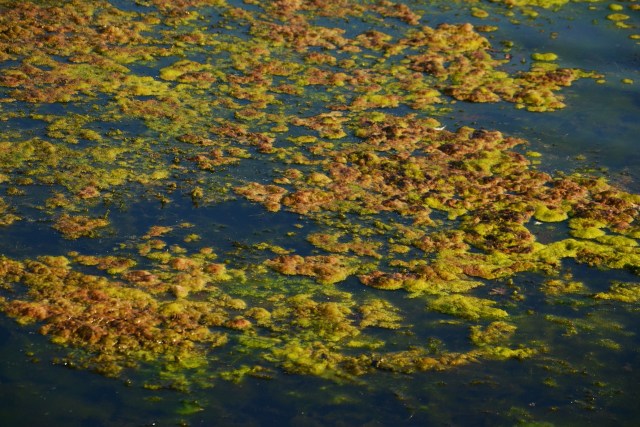Blue-Green Algae: Safe for Your Dog?
 It’s summertime and after a long and challenging winter, the warm temperatures and summer activities feel wonderful!
It’s summertime and after a long and challenging winter, the warm temperatures and summer activities feel wonderful!
But, if your dog joins you in your summer activities, it’s important to know what dangers are lurking about to effectively protect them.
In earlier posts, we’ve talked about many of the warm weather dangers waiting for your dog, including:
- Heartworm and ticks;
- Mulch and composting;
- Deadly rattlesnakes driven out of their natural homes due to excessive rain;
- The most toxic plant to your dog, the Water Hemlock; and
- The tiny, but deadly foxtails.
Today’s subject is something you also find in the summer; especially in warm, stagnant ponds and lakes with low water flow which may also receive runoff from fertilized fields; namely, blue-green algae. Runoff with residual fertilizer creates an excess of nitrogen and phosphorus in the warm water which leads to an overgrowth of algae, typically called a “bloom” (a floating mat of scum).
Not All Algae is Created Equal
Not all blue-green algae is toxic. Spirulina, a freshwater, blue-green algae, is actually a beneficial whole food supplement (i.e., superfood) for humans and animals. However, in the case of toxic blue-green algae, even a casual encounter presents a life-threatening emergency for dogs and pets.
“Harmful (algae) blooms usually smell bad and resemble pea soup, green paint or floating mats of scum.” (Dr. Karen Becker)
Since it’s practically impossible to determine whether algae is toxic by just looking at it, always err on the side of safety and keep your dog/pet/children and yourself out of all bodies of water where algae is present.
Even dogs wading into the water with blooms can suffer seizures and convulsions; and even breathing in droplets of algae-contaminated air can cause illness.
Symptoms of Blue-Green Algae Toxicity
Blue-green algae produces deadly and toxic compounds which can cause:
- Vomiting and diarrhea;
- Lethargy, shock and coma;
- Excessive panting and salivation;
- Liver damage and failure;
- Blood in the stool; or a black, tarry stool;
- Respiratory tract inflammation and breathing difficulties;
- Irritation of the skin, eyes, nose and throat.
- Nervous system damage; muscle tremors or rigidity; seizures; and
- Death in dogs;
in as little as 30 to 60 minutes after exposure!
If you suspect your dog/pet has been exposed to blue-green algae, even briefly, immediate emergency vet care is necessary.
Since it’s much easier to avoid algae toxicity than to attempt treatment after exposure, keep your dog leashed and protected from the dangers that lurk in the summer sun and heat.
Final Notes on Blue-Green Algae
Blue-green algae is also harmful (but usually not lethal) to humans causing a rash/reddening of the skin, hives, blistering, runny nose and irritated eyes and throat. Ingestion of this toxic algae can cause nausea, vomiting, diarrhea, headache, throat irritation and muscle pain.
Blue-green algae also poses a danger to horses, cattle, sheep, goats, llamas, cats and birds.
To learn more about blue-green algae:
- “Do Not Allow Your Dog Even Casual Exposure to This Deadly Toxin” by Dr. Karen Becker on HealthyPets.Mercola.com.
- “The Dangers of Blue Green Algae: Dog Toxins and Poisons” by Myndi Brunty on DogsNaturallyMagazine.com.
- Pet Poison Helpline: “Blue-Green Algae (Cyanobacteria).”
- “This Deadly Outdoor ‘Green’ Menace can be Fatal for Your Pet” by Dr. Karen Becker on HealthyPets.Mercola.com.






